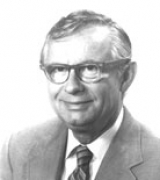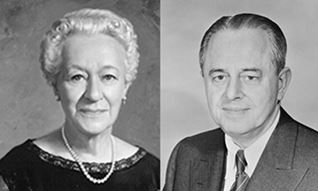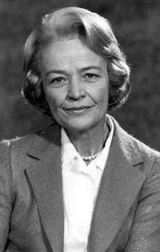A Retrospective Glance
The Krannert Cardiovascular Research Center (KCVRC) was founded in 2021 after nearly 70 years of groundbreaking research conducted by its predecessor, the Krannert Institute of Cardiology. Founded in 1952 through a generous gift from Mr. and Mrs. Herman C. Krannert, their legacy continues. Today, KCVRC investigators study and test methods to enhance clinical care and disease management for patients with heart disease, as well as explore new frontiers in prevention and novel therapies, training the next generation of physicians and researchers.
In 2021, Rohan Dharmakumar, PhD, was named the inaugural executive director of KCVRC and the Charles Fisch Chair of Cardiology. Through his leadership and recruitment of a highly skilled, multidisciplinary team of investigators, KCVRC is undergoing a revitalization and transformation driven by advances in biomedical engineering, imaging, informatics, omics and artificial intelligence.
2000s
May 2023 - The Krannert Cardiovascular Research Center and IU Health / IU School of Medicine Cardiovascular Institute host its inaugural Krannert Biennial, a unique continuing medical education event that brings both top cardiovascular researchers and clinicians together for a two-day conference.
December 2022 - The first patient enrolls in a KCVRC clinical trial to study treatment for acute heart attack complications. The goal of the study is to determine if treatment to remove residual iron within the damaged heart can lead to better outcomes in patients who have experienced an acute heart attack and are bleeding within the heart muscle.
November 2022 – A study led by Rohan Dharmakumar, PhD, identifies that iron drives the formation of fatty tissue and leads to chronic heart failure in about half of heart attack survivors. KCVRC investigators also begin running studies in the Open Chest Surgical Theater.
August 2021 – Rohan Dharmakumar, PhD, MSC, becomes executive director of the Krannert Cardiovascular Research Center, and brings new momentum to deliver the next generation of cardiovascular research.
2020 – IU School of Medicine and Indiana University Health jointly establish the Cardiovascular Institute, to enhance collaboration across the school and health system to advance research, clinical care and resident training initiatives.
February 1, 2020 – Subha V. Raman, MD, MSEE, assumes role of chief of the Division of Cardiology for IU School of Medicine, director of the Cardiovascular Institute and vice president of IU Health Cardiovascular Services.
1990s
 1995 – Douglas P. Zipes, MD, distinguished professor emeritus for the IU School of Medicine and editor-in-chief of Trends in Cardiovascular Medicine and Practice Update Cardiology, becomes director of the Cardiology Division and Krannert Institute of Cardiology, which he served through 2004.
1995 – Douglas P. Zipes, MD, distinguished professor emeritus for the IU School of Medicine and editor-in-chief of Trends in Cardiovascular Medicine and Practice Update Cardiology, becomes director of the Cardiology Division and Krannert Institute of Cardiology, which he served through 2004.
1990 – Charles Fisch, MD retires as director of the Division of Cardiology after nearly 30 years and is succeeded by Dr. David R. Hathaway. Upon Dr. Fisch’s retirement, former colleagues, students and friends endow the Charles Fisch Chair in Cardiology at IU School of Medicine. 
1990s - Peng-Sheng Chen, MD, the Medtronic Zipes professor emeritus of cardiology and editor-in-chief of Heart Rhythm, contributes to the understanding of the mechanics of fibrillation, defibrillation and the importance of the autonomic nervous system in cardiac arrhythmogenesis.
1980s
 1988 – The Krannert Charitable Trust, established by the estate of Herman and Ellnora Krannert, distributes its final assets totaling more than $200 million in higher education, the arts, community development in Indianapolis, clinical care and research. Large grants supported capital projects including the Krannert Graduate School of Management at Purdue University; the Krannert Pavilion at the Indianapolis Museum of Art (now Newfields); the Krannert Pavilion at Indiana University Hospital; and the Krannert Institute of Cardiology. Funds provided for future operations and maintenance.
1988 – The Krannert Charitable Trust, established by the estate of Herman and Ellnora Krannert, distributes its final assets totaling more than $200 million in higher education, the arts, community development in Indianapolis, clinical care and research. Large grants supported capital projects including the Krannert Graduate School of Management at Purdue University; the Krannert Pavilion at the Indianapolis Museum of Art (now Newfields); the Krannert Pavilion at Indiana University Hospital; and the Krannert Institute of Cardiology. Funds provided for future operations and maintenance.
1984 – The first implantation of the transvenous cardioverter occurs. Douglas P. Zipes, MD, pioneers the development of this device, which is placed inside the body to deliver shock that prevents death during cardiac arrest. This device also rapidly delivers ventricular pacing automatically to prevent heart arrhythmia.

1970s
1972 – The first academic book on echocardiography is published and written by Harvey Feigenbaum, MD, an Indiana University distinguished professor and professor of Medicine for the IU School of Medicine.
1960s
1968 – Harvey Feigenbaum, MD, develops the M-mode technique for measuring left ventricular dimensions. Also in 1968, the first academic course dedicated to cardiac ultrasound was taught in Indianapolis.
1965 – Following the initial evolution of echocardiography in the 1950s, Harvey Feigenbaum, MD and his colleagues detect pericardial effusion with ultrasound.
 1964 – Suzanne B. Knoebel, MD, MACC, becomes the first female cardiology faculty member at IU School of Medicine. During her career at IUSM, Dr. Knoebel and her colleagues devised a way to record the fetal electrocardiogram and maternal electrocardiogram simultaneously – a “six-foot electronic gadget” known as a fetal heart monitor today. She also served as associate director of the Krannert Institute and assistant dean for research for the school.
1964 – Suzanne B. Knoebel, MD, MACC, becomes the first female cardiology faculty member at IU School of Medicine. During her career at IUSM, Dr. Knoebel and her colleagues devised a way to record the fetal electrocardiogram and maternal electrocardiogram simultaneously – a “six-foot electronic gadget” known as a fetal heart monitor today. She also served as associate director of the Krannert Institute and assistant dean for research for the school.
November 1963 – IU School of Medicine dedicates its first building to house the Krannert Institute of Cardiology, with 6000 square feet of research and administrative space. Their research focused on clinical electrophysiology, myocardial blood flow, exercise physiology and computer applications in cardiology. The institute fostered an interactive, correlative and multidisciplinary research program, that advanced basic and clinical research, patient care and cardiovascular education.

1962 – The Krannert Institute of Cardiology receives its first large grant from the National Institutes of Health.
1960 – Herman C. Krannert and Ellnora D. Krannert establish the Krannert Charitable Trust. Also in 1960, Drs. Suzanne B. Knoebel, Charles A Hunter, Jr., Robert J. Braunlin and Kenneth G. Lansford, receive a patent for the method of obtaining a fetal electrocardiogram.
1950s
1953 – Dr. Charles Fisch becomes the founding director of the Robert M Moore Heart Clinic and leads efforts to recruit faculty and postgraduate trainees to expand cardiovascular research. Dr. Fisch’s research interests were in basic and clinical electrophysiology, the study of disorders of heart rhythm, which continue currently at the Krannert Cardiovascular Research Center. He played a pivotal role in the establishment of guidelines on the Assessment of Diagnostic and Therapeutic Cardiovascular Procedures through a joint task force of the American College of Cardiology and the American Heart Association, and served on several National Institutes of Health committees, policy and data monitoring boards.
1952 – Herman and Ellnora Krannert establish the Robert M. Moore Heart Clinic, where clinical investigators researched the causes, prevention and therapy of heart disease and trained physicians.
